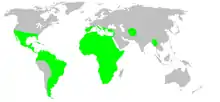Wafer trapdoor spider
The wafer trapdoor spiders, family Cyrtaucheniidae,[3] are a widespread family of spiders that lack the thorn-like spines on tarsi and metatarsi I and II (the two outermost leg segments) found in true trapdoor spiders (Ctenizidae).
| Wafer trapdoor spider | |
|---|---|
 | |
| F. lucasae, female | |
| Scientific classification | |
| Kingdom: | Animalia |
| Phylum: | Arthropoda |
| Subphylum: | Chelicerata |
| Class: | Arachnida |
| Order: | Araneae |
| Infraorder: | Mygalomorphae |
| Clade: | Avicularioidea |
| Family: | Cyrtaucheniidae Simon, 1892[1] |
| Diversity[2] | |
| 11 genera, 107 species | |
 | |
Etymology
The name derives from the Greek κυρταύχην, kyrtaúchēn, which in turn is derived from Greek κυρτός kyrtós, meaning "curved", "arched" or "bent", αὐχήν auchen, meaning the cervix or neck, and the suffix -idae, which designates belonging to a family.
Biology
Many, but not all, make wafer-like doors to their burrows, while others build the cork-like doors found commonly in the true trapdoor spiders. The biology of nearly all the species is poorly known.
The monotypic Angka hexops has only six eyes, with the posterior median eyes missing. It is up to 15 mm long in both sexes.[4]
Distribution
The family is well represented South America, and Africa. A currently undescribed genus in the western United States may hold an altitude record for the family, being found up to over 11,000 feet (3,300 meters). The genus Anemesia is found only in Central Asia, and Cyrtauchenius reaches from Algeria north to Italy, with one species found in the USA. Angka is endemic to the cloud forest of Doi Inthanon, Thailand.
Genera
The former subfamily Euctenizinae from the US and Mexico were promoted to family rank as Euctenizidae in 2012, and are now considered more closely related to Idiopidae.[5] Further changes to the circumscription of the family were made in 2020. As of July 2020, the World Spider Catalog accepted the following genera:[5]
- Acontius Karsch, 1879 — Africa, Argentina
- Ancylotrypa Simon, 1889 — Africa
- Anemesia Pocock, 1895 — Asia
- Bolostromoides Schiapelli & Gerschman, 1945 — Venezuela
- Bolostromus Ausserer, 1875 — South America, Caribbean, Panama, Uganda
- Cyrtauchenius Thorell, 1869 — Algeria, United States
- Fufius Simon, 1888 — South America, Trinidad
- Rhytidicolus Simon, 1889 — Venezuela
Genera formerly placed in the family include:
- Amblyocarenum Simon, 1892 → Nemesiidae
- Angka Raven & Schwendinger, 1995 → Microstigmatidae
- Homostola Simon, 1892 → Bemmeridae
Footnotes
- "Family: Cyrtaucheniidae Simon, 1889", World Spider Catalog, Natural History Museum Bern, retrieved 2015-11-11
- "Currently valid spider genera and species", World Spider Catalog, Natural History Museum Bern, retrieved 2015-11-11
- Raven, R.J. 1985. The spider Infraorder Mygalomorphae (Araneae): cladistics and systematics. Bulletin of the American Museum of Natural History 182: 1-180.
- Murphy, Frances & Murphy, John (2000). An Introduction to the Spiders of South East Asia. Kuala Lumpur: Malaysian Nature Society.
- "Family: Cyrtaucheniidae Simon, 1889". World Spider Catalog. Natural History Museum Bern. Retrieved 2020-07-15.
References
- Raven, Robert J. (1985). "The spider Infraorder Mygalomorphae (Araneae): cladistics and systematics". Bulletin of the American Museum of Natural History 182: 1-180.
- Platnick, Norman I. (2008). "The world spider catalog, version 8.5". American Museum of Natural History.
| Wikispecies has information related to Cyrtaucheniidae. |
| Wikimedia Commons has media related to Cyrtaucheniidae. |